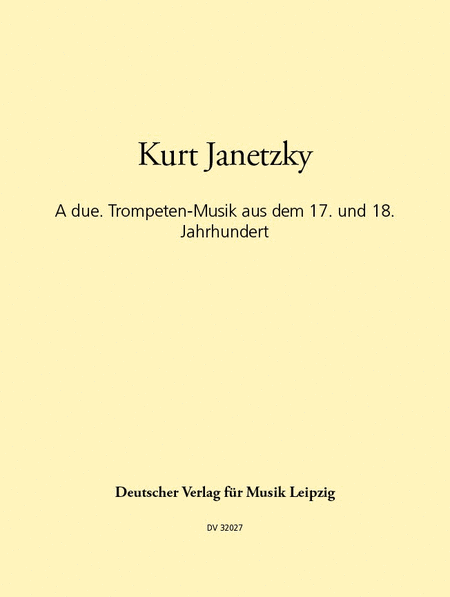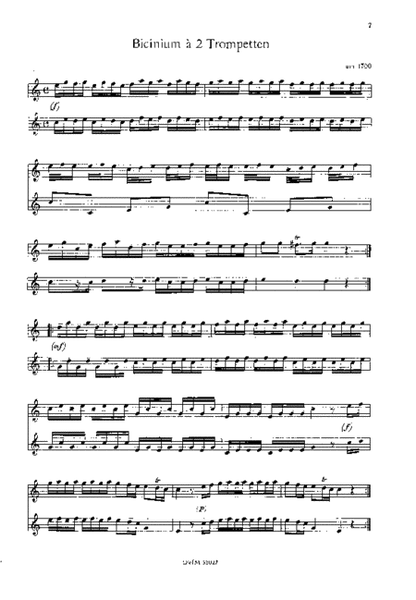a due
Trumpet Music of the 17th and 18th Centuries
Details
Description
SKU: BR.DV-32027
Trumpet Music of the 17th and 18th Centuries. Composed by Kurt (Hrsg.) Janetzky. Edited by Kurt Janetzky. Solo instruments; Softcover. Deutscher Verlag. Z.T. mit Pauken und B.c. Baroque period. Score. 24 pages. Deutscher Verlag fur Musik #DV 32027. Published by Deutscher Verlag fur Musik (BR.DV-32027).ISBN 9790200425192. 9 x 12 inches.
Bicinia - unaccompanied duos - have been known to us from the fifteenth century onwards. So quite early on it was customary tu practise this type of musical exercise, which later, especially during the Romantic period, achieved great popularity as the duo or duett. Equal numbers of this sort of instrumental duo were composed for nearly all wind and string instruments. On the other hand, only a small amount of compositions for two trumpets have come down to us. In order to play any music which progresses beyond pure fanfare on a natural (valueless) trumpet, it is necessary to make use of the clarion register (the top third of the natural harmonic). And if such a melody is to be accompanied by a second part, only the few natural notes lying below it are left, or else this high register itself, which calls for great virtuosity on the part of the trumpeter. As well as this, we must remember the fact that trumpet-playing was only allowed for the trumpeters of a royal court, army, staff, or for the field-trumpeter of a prince, plus a few council, city, and church musicians, who were bound by strict guild and corporation rules. Thus in spite of the preference for its festive sound, the spread and handing down of trumpet music was almost reduced to nothing under these circumstances. As well as this, pride of place and profession rivalry and envy amongst musicians contributed in large part. In England the situation was somewhat freer. Here pretty little trumpet duos originated, including, amongst others, those written by Handel for his master-trumpeter Valentin Snow and the Royal Sergeant-trumpeters of the Shore family. An especially happy exception was the diocese of Olmiitz. Here there was a capable group of musicians of the chapel royal with the brilliantly talented group of trumpeters and the field-trumpeter Pavel Vajvanovsky, who also composed himself. These trumpeters in the service of his prince-bishop played many sacred and secular pieces, all for several instruments. It was for them also that Heinrich Ignaz Franz Biber wrote the 12 double trumpet sonatas we present here. On the other hand, the representatives of the authorities in Germany ensured strict observation of all edicts and regulations. Even the celebrated Bach-trumpeter and towm-piper Gottfried Reiche was never allowed to be portrayed with a "proper" trumpet due to the priveleges of court and field trumpeters. In order to represent him as one of the greatest masters of his time and art, however, the painter placed an instrument similar to a corno-di-caccia in his hand, together with a sheet with a small piece for virtuoso clarion. When we try in spite of these difficulties and adverse circumstances to gather a collection of musically valuable and characteristic examples of popular pieces for two trumpets from the seventeenth and eighteenth centuries, it is in the first, place in order to acquaint modern trumpeters with something of the wealth of music, which can also be well played on a modern trumpet with valves. The originally used trumpets correspond to modern ones in the keys of C and D, but this does not mean that many of the pieces cannot be transposed to a more comfortable register. On top of this, we have tried to give a picture of the baroque court and field trumpeter, as well as of the mysterious clarion trumpeter, with the help of musically popular material. The origin of most of the pieces used is no longer clearly discernable. In most cases we possess second- or third-hand copies which have been handed down, and show signs of frequent use. A few cases where "modernization" of the second part obviously did not take place until the invention of stops, have been re-shaped into their supposed original form. A series of further dynamic details were left, and marked as optional suggestions in brackets. Kurt Janetzky
z.T. mit Pauken und B.c.


 Share
Share